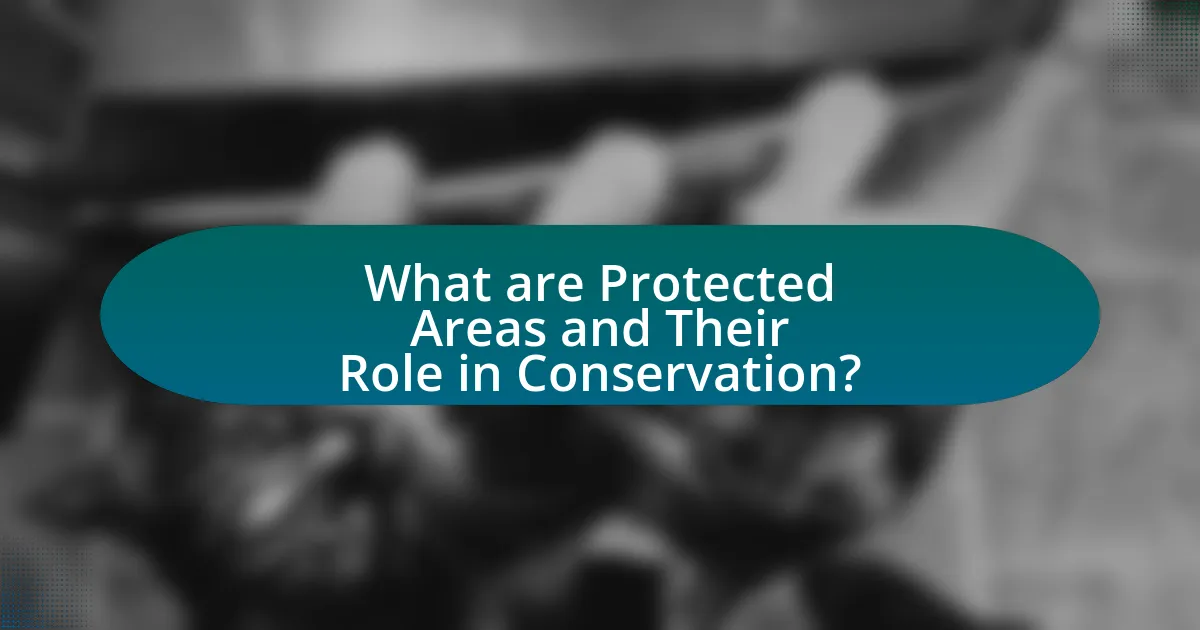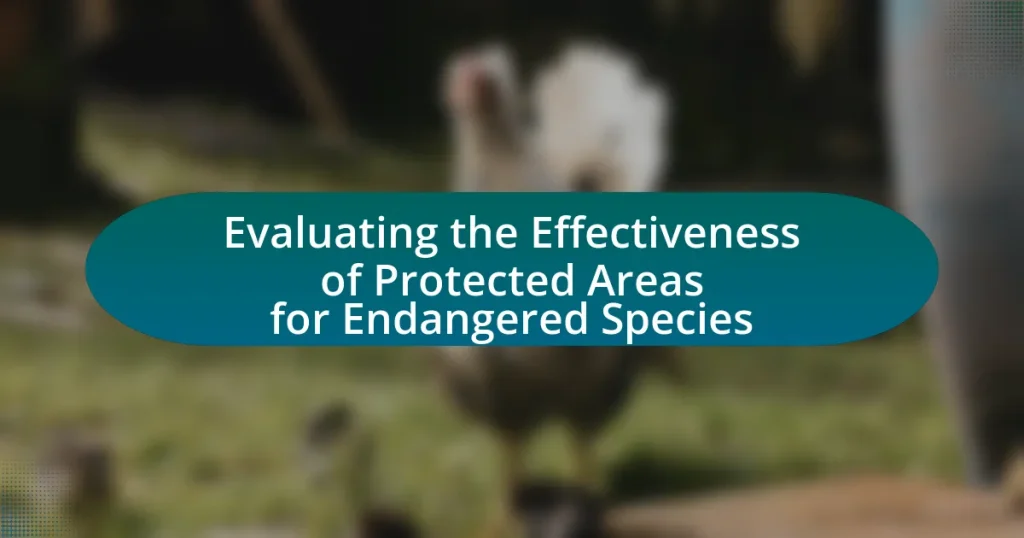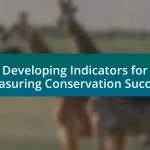Protected areas are designated regions that play a crucial role in conserving biodiversity and natural resources, covering approximately 15% of the Earth’s land surface. This article evaluates the effectiveness of protected areas in safeguarding endangered species by examining their contributions to habitat preservation, species recovery, and ecosystem health. It discusses various types of protected areas, the processes for their designation and management, and the metrics used to assess their success. Additionally, the article highlights the challenges faced in evaluating these areas and offers best practices and innovative approaches to enhance their effectiveness in conservation efforts.

What are Protected Areas and Their Role in Conservation?
Protected areas are designated regions aimed at conserving biodiversity and natural resources. Their role in conservation includes safeguarding habitats, protecting endangered species, and maintaining ecosystem services. According to the International Union for Conservation of Nature (IUCN), protected areas cover approximately 15% of the Earth’s land surface and play a critical role in mitigating biodiversity loss. Research indicates that well-managed protected areas can significantly enhance species populations and promote ecological resilience, as evidenced by studies showing that species within these areas have higher survival rates compared to those outside.
How do Protected Areas contribute to the conservation of endangered species?
Protected Areas contribute to the conservation of endangered species by providing a safe habitat that reduces human-induced threats such as habitat destruction, poaching, and pollution. These designated regions often encompass critical ecosystems that support the survival of vulnerable species, allowing them to thrive in a controlled environment. For instance, a study published in the journal “Conservation Biology” found that protected areas have been effective in maintaining biodiversity, with species populations showing significant recovery in regions where human activities are restricted. This evidence underscores the importance of Protected Areas in safeguarding endangered species and promoting ecological balance.
What types of Protected Areas exist for species conservation?
Protected Areas for species conservation include National Parks, Wildlife Reserves, Marine Protected Areas, and Conservation Areas. National Parks are designated to protect natural environments and biodiversity, often allowing for public enjoyment while restricting resource extraction. Wildlife Reserves focus on the protection of specific species and their habitats, often with stricter regulations on human activities. Marine Protected Areas safeguard marine ecosystems and species, limiting activities like fishing and drilling to preserve biodiversity. Conservation Areas are designated for the protection of specific habitats or ecosystems, often involving community management and sustainable practices. These classifications are recognized globally and are essential for maintaining biodiversity and protecting endangered species.
How are Protected Areas designated and managed?
Protected Areas are designated through a formal process that typically involves government agencies, non-governmental organizations, and local communities, often guided by national and international conservation policies. The management of these areas is carried out through specific regulations and practices aimed at preserving biodiversity, which may include habitat restoration, monitoring species populations, and enforcing protection laws. For instance, the International Union for Conservation of Nature (IUCN) provides a framework for categorizing protected areas based on their management objectives, which helps ensure that conservation efforts are effective and tailored to the specific ecological needs of the area.
Why are Protected Areas critical for biodiversity?
Protected Areas are critical for biodiversity because they provide essential habitats that protect various species from extinction. These designated regions help conserve ecosystems by safeguarding the natural environments where diverse flora and fauna thrive. According to the International Union for Conservation of Nature, Protected Areas cover approximately 15% of the Earth’s land and 7% of its oceans, playing a vital role in preserving biodiversity hotspots and preventing habitat loss. Furthermore, studies show that Protected Areas can significantly enhance species richness and abundance, as they limit human activities that lead to habitat degradation and fragmentation.
What is the relationship between Protected Areas and ecosystem health?
Protected Areas significantly enhance ecosystem health by providing habitats that support biodiversity and protect ecological processes. These designated regions help maintain species populations, promote genetic diversity, and facilitate ecosystem services such as water purification and carbon storage. Research indicates that Protected Areas can reduce habitat loss and degradation, which are critical factors in maintaining ecosystem integrity. For instance, a study published in “Nature” by Geldmann et al. (2019) found that Protected Areas are effective in conserving biodiversity, with species richness being higher in these areas compared to unprotected regions. This evidence underscores the vital role of Protected Areas in sustaining ecosystem health.
How do Protected Areas help mitigate threats to endangered species?
Protected Areas help mitigate threats to endangered species by providing a secure habitat that reduces human interference and habitat destruction. These designated regions limit activities such as logging, mining, and urban development, which are primary threats to wildlife. For instance, a study published in “Conservation Biology” by Geldmann et al. (2013) found that protected areas significantly reduce the risk of species extinction by maintaining biodiversity and ecosystem integrity. By safeguarding critical habitats, Protected Areas enable endangered species to thrive and recover from population declines.

How is the Effectiveness of Protected Areas Evaluated?
The effectiveness of protected areas is evaluated through various metrics, including biodiversity assessments, species population monitoring, and habitat condition evaluations. These methods provide quantitative data on the conservation outcomes within protected areas. For instance, studies have shown that protected areas can lead to a significant increase in species populations, with some reports indicating a 50% increase in certain endangered species within a decade of protection. Additionally, the effectiveness is often assessed using ecological indicators, such as species richness and ecosystem health, which reflect the overall success of conservation efforts. Monitoring programs, such as the Global Biodiversity Outlook, provide comprehensive data that supports these evaluations, demonstrating the positive impact of protected areas on biodiversity conservation.
What metrics are used to assess the effectiveness of Protected Areas?
Metrics used to assess the effectiveness of Protected Areas include biodiversity indicators, habitat quality assessments, species population trends, and ecological integrity measures. Biodiversity indicators evaluate the variety and abundance of species within the area, while habitat quality assessments determine the health and sustainability of ecosystems. Species population trends track changes in the numbers of endangered species over time, providing insight into conservation success. Ecological integrity measures assess the overall functioning of ecosystems, including interactions among species and their environments. These metrics collectively provide a comprehensive evaluation of how well Protected Areas fulfill their conservation objectives.
How do population trends of endangered species indicate success?
Population trends of endangered species indicate success through measurable increases in their numbers and distribution within protected areas. When populations of endangered species show a consistent upward trend, it reflects effective conservation strategies, habitat restoration, and successful management practices. For instance, the recovery of the gray wolf population in Yellowstone National Park, which increased from a mere 31 individuals in 1995 to over 1,700 by 2020, demonstrates the positive impact of protected areas on species recovery. Such data validates the effectiveness of conservation efforts and highlights the importance of maintaining and expanding protected habitats to ensure the survival of endangered species.
What role does habitat quality play in evaluating effectiveness?
Habitat quality is crucial in evaluating the effectiveness of protected areas for endangered species, as it directly influences species survival and reproductive success. High-quality habitats provide essential resources such as food, shelter, and breeding sites, which are vital for the persistence of endangered species. Studies have shown that areas with better habitat quality support higher populations and greater biodiversity, indicating that effective conservation strategies must prioritize habitat enhancement and restoration. For instance, research published in “Conservation Biology” by Lindenmayer and Fischer (2006) highlights that habitat degradation leads to population declines, underscoring the need for maintaining and improving habitat quality to ensure the effectiveness of conservation efforts.
What challenges exist in evaluating Protected Areas?
Evaluating Protected Areas presents several challenges, primarily due to the complexity of biodiversity, varying management practices, and the difficulty in measuring ecological outcomes. The diversity of species and ecosystems within these areas complicates the assessment of their effectiveness, as different species may respond differently to conservation efforts. Additionally, inconsistent management practices across various Protected Areas can lead to discrepancies in data collection and evaluation methods, making it hard to compare results. Furthermore, measuring ecological outcomes often requires long-term data, which may not be available, leading to gaps in understanding the true impact of these areas on endangered species. These challenges highlight the need for standardized evaluation frameworks and comprehensive data collection to accurately assess the effectiveness of Protected Areas.
How do external factors influence the effectiveness of Protected Areas?
External factors significantly influence the effectiveness of Protected Areas by impacting biodiversity conservation and management practices. For instance, human activities such as agriculture, urban development, and pollution can encroach on protected zones, leading to habitat degradation and species displacement. A study published in “Conservation Biology” by Watson et al. (2014) found that 70% of protected areas are affected by external pressures, which can undermine their conservation goals. Additionally, climate change alters ecosystems surrounding these areas, affecting species migration patterns and resource availability. Therefore, the effectiveness of Protected Areas is contingent upon managing these external influences to ensure the preservation of endangered species.
What are the limitations of current evaluation methods?
Current evaluation methods for assessing the effectiveness of protected areas for endangered species are limited by several factors, including a lack of standardized metrics, insufficient long-term data, and inadequate consideration of ecological dynamics. These limitations hinder the ability to accurately measure conservation outcomes and the overall impact of protected areas. For instance, many evaluation frameworks rely on inconsistent indicators, which can lead to varying interpretations of success across different regions. Additionally, the scarcity of longitudinal studies restricts the understanding of how protected areas evolve over time and their effectiveness in species recovery. Furthermore, current methods often overlook critical ecological interactions and external pressures, such as climate change and habitat fragmentation, which can significantly influence species survival.

What Best Practices Enhance the Effectiveness of Protected Areas?
Best practices that enhance the effectiveness of protected areas include establishing clear management objectives, engaging local communities, implementing effective monitoring and evaluation systems, and ensuring adequate funding and resources. Clear management objectives guide conservation efforts and help prioritize actions, while community engagement fosters local stewardship and compliance with regulations. Effective monitoring and evaluation systems allow for adaptive management by assessing the impact of conservation strategies, and adequate funding ensures that protected areas have the necessary resources for maintenance and enforcement. Research indicates that protected areas with strong community involvement and sufficient funding are more successful in conserving biodiversity, as evidenced by studies showing that community-managed areas often outperform strictly protected ones in terms of species recovery and habitat preservation.
How can management strategies improve outcomes for endangered species?
Management strategies can improve outcomes for endangered species by implementing targeted conservation actions that address specific threats to their survival. For instance, habitat restoration, legal protection, and species monitoring are essential components of effective management strategies. Research indicates that protected areas, when managed properly, can lead to a 50% increase in species populations over a decade, as demonstrated by the success of the Yellowstone to Yukon Conservation Initiative, which has shown significant recovery of various species through coordinated management efforts. Additionally, adaptive management practices allow for ongoing assessment and modification of strategies based on ecological feedback, ensuring that conservation efforts remain effective in changing environments.
What role does community involvement play in the success of Protected Areas?
Community involvement is crucial for the success of Protected Areas as it fosters local stewardship and enhances conservation efforts. Engaging communities leads to increased awareness and support for biodiversity conservation, which is essential for the sustainability of these areas. Studies have shown that when local populations participate in management and decision-making processes, there is a higher likelihood of compliance with conservation regulations and practices. For instance, a study published in the journal “Conservation Biology” found that Protected Areas with strong community engagement reported better outcomes in terms of species recovery and habitat preservation. This evidence underscores the importance of integrating community perspectives and knowledge into conservation strategies to achieve effective management of Protected Areas.
How can adaptive management be applied in Protected Areas?
Adaptive management can be applied in Protected Areas by implementing a systematic process that integrates learning and decision-making to improve conservation outcomes. This approach involves setting clear management objectives, monitoring ecological conditions, and adjusting strategies based on observed outcomes and new information. For instance, the U.S. National Park Service employs adaptive management to address challenges such as invasive species and climate change impacts, allowing for real-time adjustments to management practices based on ongoing research and monitoring data. This iterative process enhances the effectiveness of conservation efforts for endangered species by ensuring that management actions are responsive to changing environmental conditions and species needs.
What are the key recommendations for future Protected Area initiatives?
Key recommendations for future Protected Area initiatives include enhancing connectivity between protected areas, implementing adaptive management strategies, and increasing stakeholder engagement. Enhancing connectivity allows for wildlife movement and genetic exchange, which is crucial for species survival, as evidenced by studies showing that fragmented habitats lead to decreased biodiversity. Implementing adaptive management strategies enables the adjustment of conservation practices based on monitoring and evaluation, ensuring that initiatives remain effective in changing environmental conditions. Increasing stakeholder engagement fosters community support and participation, which has been shown to improve conservation outcomes, as communities often have valuable local knowledge and vested interests in the health of their ecosystems.
How can policy changes support the effectiveness of Protected Areas?
Policy changes can enhance the effectiveness of Protected Areas by establishing stronger legal frameworks, increasing funding for conservation efforts, and promoting community involvement in management. Stronger legal frameworks ensure that regulations are enforced, which can lead to reduced poaching and habitat destruction; for example, the implementation of stricter anti-poaching laws in Kenya has resulted in a significant decrease in elephant poaching rates. Increased funding allows for better resources to monitor and manage these areas, as seen in the U.S. National Park Service, which has improved visitor services and conservation programs through increased budget allocations. Furthermore, promoting community involvement fosters local stewardship, as evidenced by the success of community-managed marine protected areas in the Philippines, where local fishers have seen increased fish populations and improved livelihoods.
What innovative approaches can be adopted for better conservation outcomes?
Innovative approaches for better conservation outcomes include the use of technology, community engagement, and adaptive management strategies. Technology, such as satellite imagery and drones, enhances monitoring of protected areas, allowing for real-time data collection on wildlife populations and habitat conditions. Community engagement fosters local stewardship, as involving indigenous and local communities in conservation efforts has been shown to improve biodiversity outcomes, evidenced by the success of community-managed marine areas in places like Fiji. Adaptive management strategies, which involve continuous learning and adjustment of conservation practices based on monitoring results, have been effective in various ecosystems, as demonstrated by the U.S. National Park Service’s approach to managing changing climate impacts on park resources.
What practical steps can be taken to evaluate and improve Protected Areas?
To evaluate and improve Protected Areas, implement systematic monitoring and assessment of biodiversity, habitat conditions, and management effectiveness. This involves establishing baseline data through biodiversity surveys and ecological assessments, which can be compared over time to measure changes in species populations and habitat quality. For instance, the World Wildlife Fund emphasizes the importance of using indicators such as species richness and population trends to assess the health of ecosystems within Protected Areas. Additionally, engaging local communities in conservation efforts and incorporating their traditional knowledge can enhance management strategies, as evidenced by successful case studies in various regions where community involvement led to improved conservation outcomes. Regularly reviewing management plans based on these evaluations ensures adaptive management, allowing for timely adjustments to strategies that address emerging threats or changing environmental conditions.


